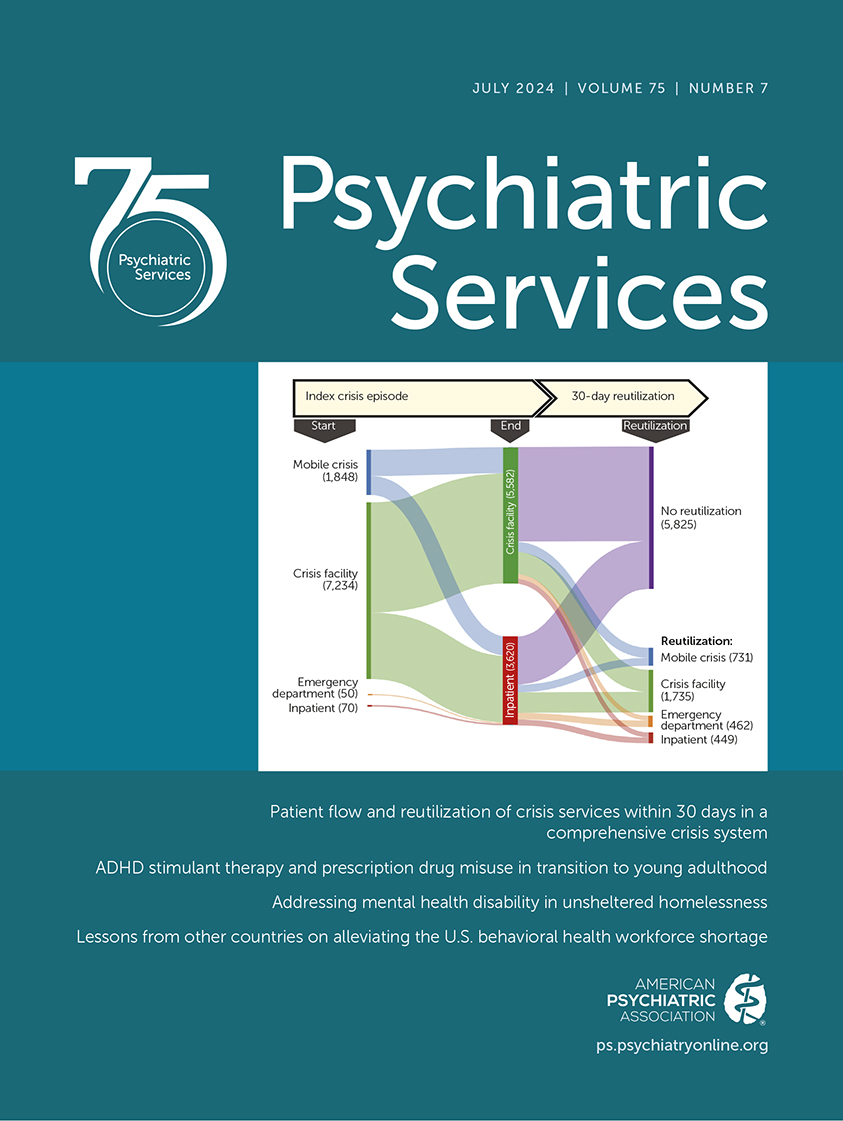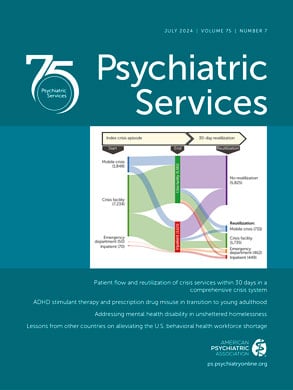Approximately 53 million American adults and 7.7 million children experience mental illness, but the shortage of qualified behavioral health professionals prevents many of them from accessing treatment (
1). Increasing the numbers of providers in the U.S. behavioral health workforce who are trained in evidence-based practices would not only improve access to care but could also target the substance use epidemic and reduce hospitalization costs and readmission rates (
2). Although occupational therapy is a profession capable of addressing these concerns, current policies prohibit it from doing so (
3).
Occupational Therapy Is a Viable Solution
Born out of the moral treatment movement and psychiatric hospitals more than 100 years ago, occupational therapy is at its core a behavioral health profession. The educational standards for this profession require didactic and experiential learning in behavioral health practices (
4). Occupational therapy practitioners (OTPs) are skilled at assessing the person and their environments, routines, daily activities, and occupations. The goal of the occupational therapy process is to better align the environment, activities, and person such that quality of care increases, improving satisfaction, health, and wellness for individual persons, groups, or communities (
5). OTPs use evidence-based practices and skilled interventions focused on the cognitive, sensory, social-emotional, and physical impacts of behavioral health disorders. Despite being highly capable and trained to work on behavioral health teams and manage behavioral health disorders, OTPs are disproportionately affected by state and federal policies that define health care professionals and teams. These policies include state rules that specify who is considered a mental health provider or professional, state rules and language stating who can bill Medicaid, national policies that support health care professionals in receiving recognition of their behavioral health care value, and policies within the Medicaid and Medicare rules at the national level. Such policies preclude OTPs from practicing as qualified mental health providers.
These restrictions not only prohibit OTPs from joining the behavioral health workforce but have led to variations in where they are able to practice on behavioral health teams. For example, only eight U.S. states (Illinois, Maine, Michigan, Missouri, Montana, Oregon, Tennessee, and Virginia) include occupational therapy in their definition of qualified mental health providers (
6). Moreover, only three states (Indiana, Kentucky, and Nevada) have changed Medicaid language to reflect that OTPs can bill Medicaid for mental health treatment. Current workforce data indicate that OTPs working in behavioral health make up only 2.2% of the nationwide occupational therapy workforce, across practice settings, rehabilitation hospitals, schools, academia, private practice, and others (
7). Moreover, OTPs make up 0.2% of total employment in “offices of mental health practitioners (except physicians)” as tracked by the U.S. Bureau of Labor Statistics. In comparison, psychologists and social workers make up 14.9% and 5.4%, respectively, of that same workforce (
8).
These policy barriers result in missed opportunities to strengthen the behavioral health workforce and improve client outcomes. For example, findings from a national survey of first-episode psychosis program leaders indicated that when OTPs are included on a treatment team, they are significantly more likely than other team members to support clients’ activities of daily living and sensory processing, highlighting how OTPs may contribute to addressing gaps in care and unmet client needs (
9). Moreover, occupational therapy has been found to improve work outcomes, enhance daily life, support weight loss, and improve and maintain participation in daily activities among adults with serious mental disorders (
10–
12).
OTPs can have many roles within behavioral health given their educational training and scope of practice. Like other professions, such as supported employment specialists, case managers, therapists, nurses, psychiatrists, or skills trainers, OTPs evaluate clients’ functioning and provide interventions to promote skill acquisition and goal achievement. Given the behavioral health workforce shortage, OTPs can fill gaps on the treatment team while staying within the profession’s scope of practice. Specific services that OTPs may provide on behavioral health teams have been outlined in a national survey conducted by Thomas and colleagues (
9) and include assessing and evaluating cognition, sensory processing, and daily living skills; supporting medication management; supporting symptom management; facilitating occupation-based groups; adapting tasks and the environment to better suit clients’ strengths and needs; providing consultation to team members and community supporters (i.e., educators and employers); supporting clients in building healthy habits and routines; and collaborating with vocational service providers. OTPs can also help address challenges with daily functioning, particularly among those who experience housing instability as well as people facing substance use problems. For example, OTPs can facilitate independent living skills such as money management, home management, and pain management, which are areas of need for individuals facing behavioral health issues and their consequences (e.g., houselessness and substance use disorders). Last, OTPs, depending on the policy infrastructure of their state of residence, can provide private stand-alone practice services (
13). Therefore, through both team-based care and private practice, OTPs could reduce the behavioral health workforce shortages nationwide.
Current Advocacy Efforts
Current advocacy efforts point to viable solutions to resolve the aforementioned policy issues. The policy environment in some, but not all, states supports the inclusion of OTPs on behavioral health teams. For example, Illinois, Oregon, and Virginia have explicit language in their state Medicaid rules that licensed OTPs can serve in the role of qualified mental health providers (
14). Consequently, more OTPs are on behavioral health teams in these localities. In light of this success, advocacy efforts in other states have focused on policy change. For example, in response to a Substance Abuse and Mental Health Services Administration report calling for 10,000 more behavioral health care providers by 2025, occupational therapy academics, clinicians, and students in Indiana have lobbied the state legislature for a change to its prohibitive policies regarding the definition of behavioral health care provider (
14). Similarly, the American Occupational Therapy Association’s legislative affairs team has advocated for years that OTPs be considered as a solution to the behavioral health workforce shortage and overall behavioral health epidemic in the United States. It has recommended lobbying for the inclusion of OTPs in the required staffing list for certified community behavioral health centers and adding OTPs to the National Health Service Corps definitions (
6). These advocacy efforts are important, because a change in policy in one place has an impact on other locales, which in turn can build momentum in the efforts at both national and state levels.
Proposed Policy and Advocacy Agenda
Given the immensity of the behavioral workforce shortage facing the United States, we propose the following to change policies preventing OTPs from practicing as behavioral health providers. First, in states where OTPs are qualified providers, we suggest that OTPs themselves use their status and privilege to advocate for policy changes. Moreover, behavioral health professionals who currently work on teams with OTPs should also advocate for such changes. Second, partnerships between behavioral health agencies and OTP education programs have shown promise in demonstrating the value of occupational therapy to behavioral health stakeholders at the state and national levels. DeAngelis et al. (
15) demonstrated that an occupational therapy student internship program improves work rehabilitation outcomes for adults with serious mental illness; their program also showed how student interns, when supported by a community-academic partnership, can increase workforce numbers to meet behavioral health needs. We suggest that similar partnerships be developed to further advance the evidence base for occupational therapy within behavioral health care and advocate for its role on behavioral health teams. Third, the shortage of behavioral health workers necessitates that all stakeholders who are concerned about unmet behavioral health needs in the United States think creatively, welcome innovative solutions, and explore avenues for transformative change. We therefore call professionals and providers of behavioral health care to action. Individuals who receive care, know what occupational therapy can do, and make policy decisions should consider advocating for the elimination of the policy barriers that prohibit many consumers from accessing behavioral health treatment.
We hope that this Open Forum serves as a call to action. We as OTPs, researchers, occupational therapy educators, and allies are saying that occupational therapy can and wants to help—so help us knock down the walls preventing full availability of behavioral health services.

